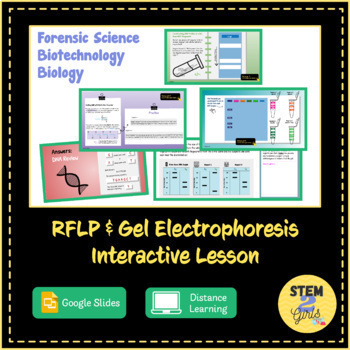Gel Electrophoresis Interactive Biotechnology Lesson DISTANCE LEARNING
- Google Drive™ folder

Description
This activity is ready for distance learning!
This is a NO PREP LESSON designed for students to learn about DNA Profiling in distance learning. The Google Slides contain preloaded templates which ask students to type, draw, drag and drop various icons to simulate the “cutting” process with restriction enzymes and the separation of DNA fragments in gel electrophoresis.
Start your lesson by showing your students the video directions and then let them take off! Students will review the basics of DNA, learn about restriction enzymes, practice “cutting DNA”, and “plotting” DNA bands on a sample gel. Students will also see how DNA fragments are sorted by size on a gel and use that to compare DNA profiles of individuals.
After the lesson, assign the RFLP & Gel Electrophoresis Practice Slides for homework, or use it the next class period as a Follow-Up. :)
The activity includes:
- RFLP & Gel Electrophoresis Interactive Google Slides lesson (20 slides)
- RFLP & Gel Electrophoresis Practice (8 slides)
- ANSWERS for Interactive Lesson & Practice
- Student-facing video directions for the Interactive Slides
BONUS: We just added an editable Google Form Quiz you can use as an exit or entrance ticket to check your student's understanding of the concepts.


